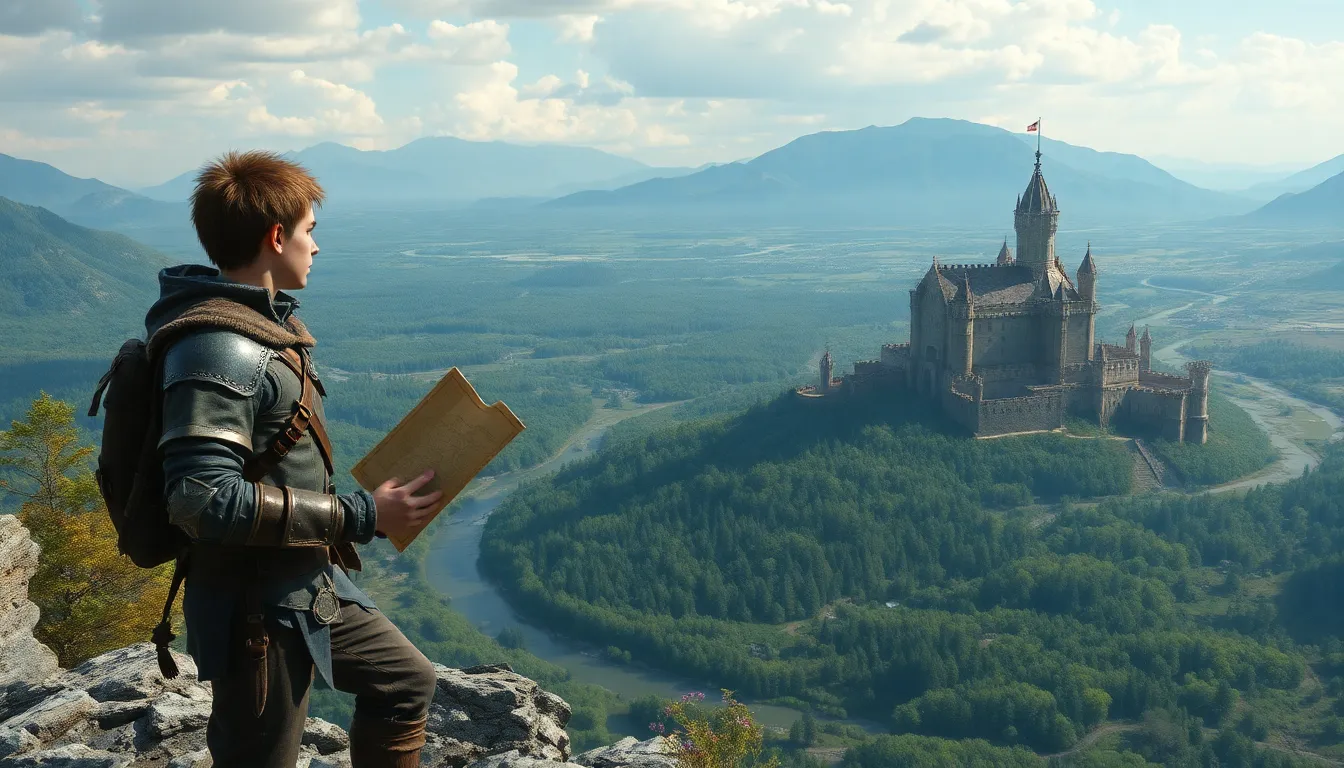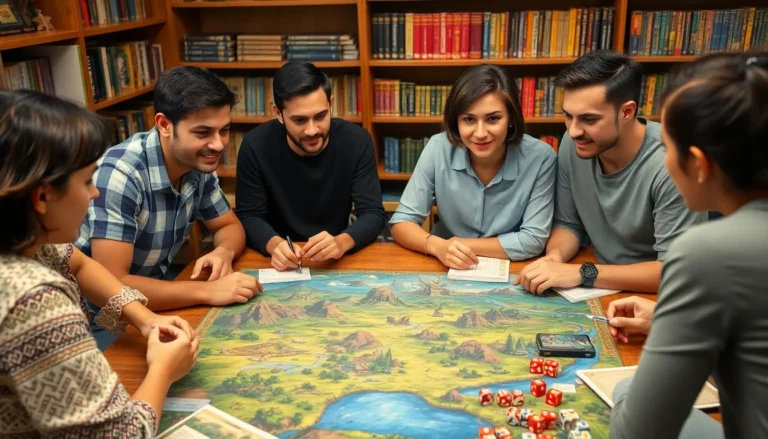Table of Contents
ToggleIn the vibrant world of role-playing games (RPGs), exploration serves as a cornerstone of the player experience. It’s not just about completing quests or battling foes; it’s about immersing oneself in rich landscapes filled with hidden secrets and untold stories. Each corner of a game world invites players to venture forth and discover what lies beyond the horizon.
As players navigate through diverse environments—from mystical forests to ancient ruins—they encounter challenges that test their skills and decision-making. This journey of exploration fosters a sense of adventure, encouraging players to forge their own paths and create unique narratives. Whether uncovering lore or collecting rare items, the thrill of discovery fuels the excitement that keeps gamers coming back for more.
What Is RPG Exploration?
RPG exploration refers to the process in which players navigate diverse environments within role-playing games to discover hidden elements, lore, and experiences. Players encounter various landscapes, such as forests, dungeons, and cities, each offering unique challenges and rewards. As they explore, players engage with their surroundings, interact with non-playable characters (NPCs), and uncover quests that enhance their overall gameplay experience.
Exploration involves solving puzzles, finding hidden items, and discovering lore-rich locations. This engagement fosters player creativity and encourages personal storytelling. Travelers in expansive worlds gain insights into the game’s narrative, enhancing their connection to the game environment.
RPG exploration serves multiple purposes. It enriches player immersion by creating a sense of wonder. It fuels a player’s curiosity and strengthens problem-solving skills through environmental challenges. The act of exploring can also lead to unexpected encounters, rewarding players with unique items or experiences that influence their journey.
Key Elements of RPG Exploration

RPG exploration thrives on various key elements that enrich the player experience. These components include world-building, quest design, and environmental storytelling, all of which contribute to immersive gameplay.
World-Building
World-building forms the foundation of any engaging RPG. It encompasses the creation of expansive, detailed environments that players can explore. Designers craft diverse ecosystems, societies, and histories, ensuring each location feels unique and alive. Examples include vast forests filled with mythical creatures, bustling cities with intricate cultures, and haunting dungeons containing ancient secrets. This depth encourages players to wander and discover, adding layers to the storytelling that can lead to unexpected encounters and rewards.
Quest Design
Quest design plays a vital role in RPG exploration. It entails creating missions that often intertwine with the game’s narrative and world. Players embark on quests that range from simple fetch tasks to elaborate story arcs. These missions guide players through exploration while encouraging engagement with the game’s mechanics. For instance, a quest might require players to investigate a haunted location, prompting exploration of nearby areas for clues or hidden items. Thoughtful quest design seamlessly integrates exploration with the unfolding narrative, driving players to explore deeper.
Environmental Storytelling
Environmental storytelling enhances immersion by using surroundings to convey narratives without explicit dialogue. This technique involves placing visual cues, such as ruins, artifacts, and ambient sounds, to suggest past events or ongoing conflicts. Players unravel stories by interpreting these environmental details, enriching their understanding of the world. For example, a weathered statue in a forgotten village can hint at its once-thriving culture, prompting players to delve into the areas around it for more lore. Effective environmental storytelling makes exploration meaningful, inviting players to engage with the landscape while piecing together the game’s broader narrative.
The Impact of RPG Exploration on Gameplay
RPG exploration significantly enhances gameplay by fostering player agency and deepening immersion. It shapes how players engage with the game world and its narrative.
Player Agency
Player agency refers to the freedom and autonomy players experience during exploration. Players make choices that influence their paths and outcomes within the game. This autonomy allows players to define their experiences, whether they choose to engage in combat, solve puzzles, or explore every nook of a vast landscape. For example, discovering a hidden cave might lead to unexpected quests, unique characters, or rare items that directly affect gameplay. The sense of control enhances player investment, making exploration a crucial component in crafting individualized stories and paths.
Immersion and Engagement
Exploration deepens immersion and keeps players engaged in the RPG narrative. Detailed environments—crafted through rich world-building and environmental storytelling—create a vibrant setting where players can lose themselves. Players are drawn into the lore embedded in landscapes, such as ancient ruins or bustling towns. Engagement increases as players interact with diverse non-playable characters (NPCs), each offering quests and insights that enrich the main narrative. The thrill of discovery maintains player interest, encouraging continuous exploration and interaction, which ultimately enhances the overall gaming experience.
Notable RPGs with Remarkable Exploration
Numerous RPGs showcase exceptional exploration mechanics, allowing players to immerse themselves in vast worlds and narratives. The following categories highlight some notable examples.
Open-World RPGs
Open-world RPGs offer expansive environments that promote free exploration. These games feature richly detailed landscapes where players can engage in various activities beyond main quests.
- The Elder Scrolls V: Skyrim: Players navigate diverse regions, from snowy mountains to lush forests, uncovering secrets, lore, and unique quests.
- The Witcher 3: Wild Hunt: A vast map filled with interactive environments allows players to explore rich narratives and meet captivating NPCs across the land.
- Breath of the Wild: Players traverse an open landscape filled with puzzles and hidden treasures, emphasizing exploration as a core gameplay mechanic.
Linear RPGs
Linear RPGs typically guide players through structured narratives while still incorporating exploration elements. These journeys often enhance the storytelling experience and engage players with their environments.
- Final Fantasy VII: Players journey through distinct areas, each filled with vibrant details and lore, fostering a sense of discovery within a set narrative path.
- Chrono Trigger: Players explore varied timelines and locations, unveiling the story through carefully designed environments that enrich the gameplay experience.
- Mass Effect: Players visit different planets and space stations, each designed to encourage exploration of hidden lore and character interactions, despite a structured storyline.
Future Trends in RPG Exploration
Future trends in RPG exploration focus on technological advancements, innovative game design, and evolving player expectations. These trends shape how players interact with game worlds, enhancing immersion and engagement.
Enhanced Virtual Reality (VR) Experiences
Enhanced VR experiences revolutionize exploration in RPGs. As VR technology improves, players engage in fully immersive environments. Gamers can explore vast landscapes and interact with characters through realistic movements, enriching the exploration experience.
Procedural Generation
Procedural generation creates diverse and unpredictable environments. With algorithms generating unique terrains, quests, and NPC interactions, players experience fresh challenges each time they play. This approach enhances replayability and appeals to players seeking exploration-driven gameplay.
Integration of Augmented Reality (AR)
Integration of AR in RPGs blurs the lines between real and virtual worlds. Players can explore familiar environments transformed by game elements, uncovering gameplay mechanics outside traditional settings. This trend encourages physical exploration while maintaining engagement with the game narrative.
AI-Driven NPCs
AI-driven NPCs provide dynamic interactions and responses. These characters adapt to player choices and exploration patterns, creating personalized experiences that reflect player decisions. Enhanced AI fosters rich storytelling and deeper connections with game worlds.
Increased Emphasis on Environmental Storytelling
Increased emphasis on environmental storytelling engages players through rich, contextual narratives. Game designers focus on visual storytelling elements, allowing players to discover backstories through exploration. Subtle clues within environments lead to a more immersive experience.
Cross-Platform Play
Cross-platform play allows seamless exploration among different devices. Players interact within shared worlds regardless of their chosen platform, expanding social dynamics and fostering community. This trend enhances cooperative exploration and the overall player experience.
Dynamic Weather and Day-Night Cycles
Dynamic weather and day-night cycles create ever-changing environments in RPGs. These features influence gameplay, affecting visibility, NPC behavior, and quest availability. Such variability enhances realism and encourages players to adapt their exploration strategies.
| Trend | Description |
|---|---|
| Enhanced VR Experiences | Immersive environments allowing realistic interactions. |
| Procedural Generation | Unique terrains and quests created algorithmically for replayability. |
| Integration of AR | Blended reality experiences encouraging exploration in familiar settings. |
| AI-Driven NPCs | Dynamic character interactions that adapt to player choices. |
| Increased Environmental Storytelling | Contextual narratives revealed through exploring environments, enhancing immersion. |
| Cross-Platform Play | Shared exploration across different devices fostering community engagement. |
| Dynamic Weather/Day-Night Cycles | Realistic climatic changes affecting gameplay and exploration strategies. |
Exploration is the heartbeat of RPGs that drives player engagement and creativity. It transforms gameplay into a journey filled with discovery and personal storytelling. As players traverse diverse landscapes they not only uncover secrets but also develop skills and make meaningful choices that shape their narratives.
With advancements in technology and innovative design the future of RPG exploration promises even richer experiences. Enhanced immersion through VR and AI-driven interactions will redefine how players engage with game worlds. As these trends evolve exploration will remain a vital element that captivates players and keeps them coming back for more adventures.






